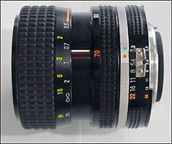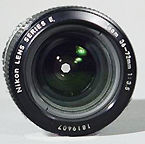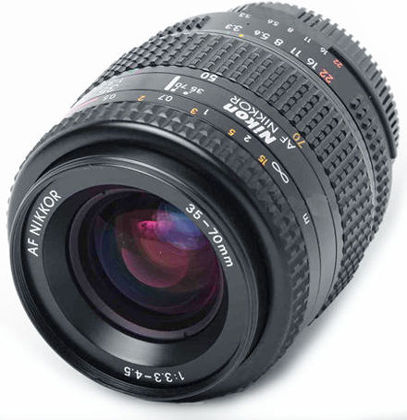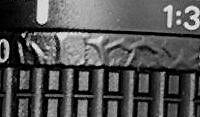PREVIEW ONLY
Introduction;- Background and Version History
Although arguably one of the best selling zoom lens in 35mm SLR photography was the immensely popular Nikon's Zoom-Nikkor 43-86mm f/3.5 (first version was introduced in 1963) but it was not Nikon's first wideangle zoom lens. According to Peter Braczho's Nikkor lens hand book, he mentioned there was an amazingly fast Wide-angle Zoom Auto-Nikkor 3.5~8.5cm 1:2.8 lens produced by Nikon as early as back in 1961. While the earliest Nikon zoom lens with a 35-70 zoom range was the Zoom-Nikkor 35-70mm f/3.5, a lens which was introduced way back in 1976 (it has another followed up model that came with MACRO function as well as an Ai-S lens spec later in 1981). So, those days, lenses were usually being introduced with an exciting version first where usually came with a fast lens speed and then followed up with other mass market consumers versions. One way of another, this common marketing practice is still being used today. In 1981, Nikon had also introduced an odd zoom lens, Series E zoom lens of an odd focal length of 36-72mm f/3.5S was primarily catered for the compact Nikon SLRs of Nikon EM, FG and FG20. The series of E-lenses didn't use "Nikkor" trade name (where they simply used a general term "Nikon lens"). Generally, the Series-E lenses were being regarded as compromised Nikkor optic but some of original designs within the series have been copied extensively for making of autofocus Nikkor lenses. Another budget zoom lens, Zoom Nikkor 35-70mm f/3.3~4.5S was introduced in 1984. It was the first among the 35-70mm zoom lens group that has adopted a variable aperture design. Towards the mid of the '80, 35-70mm zoom lenses have gradually began replacing traditional standard 50mm lenses as "Standard Zoom" that may either sold individually or as bundled unit for some of the new Nikon SLR camera sold during that era.
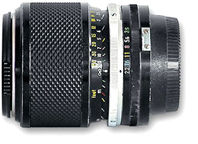 |
|
|
|
|
|
|
 |
Stray Dogs at a Nomad Hut, Inner Mongolia. |
![]()
Part One Nikon's AF Zoom Nikkor 35-70mm f/3.3~4.5S
MACRO MK
I wideangle-telephoto zoom lens
Year introduced: 1986; Discontinued: 1989
The Nikon AF Zoom-Nikkor 35-70mm f/3.3~4.5S was among the initial batch of Nikon autofocus lenses designed for the AF Nikon F501 / N2020 SLR camera in 1986. Technically, the lens virtually carried over the same optical composition used in the manual focus version. It was actually offered as a bundled standard lens (zoom instead) for the F301 (MF) and AF F501 as well as many of the consumer class Nikon autofocus SLRs that followed after the said two SLR camera models.Sleek and extremely compact, weighing just at 260g (but slightly heavier than the MF version it replicates from) and measuring 70.5mm x 61mm - making the tiny zoom lens as one of the most compact AF Nikkor zoom lens you can find in the market during that early period of AF photography. Naturally, it has a modest entry price so as to attract first time SLR buyers to get into the Nikon 35mm photographic system.
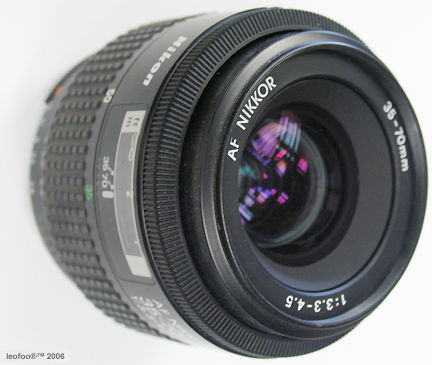 |
Early generation of AF Nikkor lenses has a very thin and narrow manual focus ring at the front which actually made out of compressed compound plastic. The AF 35-70 Zoom is no exception and carried with the same configuration. This unwelcome design had raised heavy criticism among Nikon photographers because during the transitional change from manual to autofocus era. Perhaps may be Nikon had been too optimistic with their designs or under estimated the possible reaction from the many owners of older Nikon bodies who may require the AF lenses to be shared with their older Nikon SLR bodies. On a practical note, using the stupidly designed manual focusing in these series of AF Nikkor can be quite uncomfortable during shooting. But why people like to focus on the issue ? Simple. It has a lot to do with the sluggish performance of the early Nikon SLR camera's autofocus system. They tend to hunt for focus and often exhibits this behavior when aiming subject with less defined outlines or low contrast scenes. So, this may require user to revert back to manual focusing. |
Generally, the overall built quality of the early AF Nikkor lenses were less desirable especially when you made comparison with the older series of manual focus equivalent. To begin with, the Nikon AF Zoom-Nikkor 35-70mm f/3.3~4.5S's zoom range was started with a moderate wideangle of 35mm and ends at a moderate short telephoto range. To the seasoned photographers, it probably has limited use and generally it has been categorized as a general purpose zoom lens. The zoom control in this version uses rotating zoom type design where you rotate and choose the right focal length between 35-70mm to fit your composition. During zooming and/or focusing, the lens also extends in length and rotates physically. There are three focal length indicators of 35mm (green), 50mm White and 70mm Yellow marked around the ring to serve as visual reference of the particular zoom setting you have chosen. Due to its nature of using variable aperture and hence, this also affects the zoom action and there are two indexes, each for 35mm and 70mm. For a 2X zoom ratio zoom lens, the rotation during zooming from 35mm to 70mm can be considered quite wide apart. Slight stiffness was experienced on the used unit that I tested. But the manual focusing ring provides a smoother rotation (loose to be exact and as if lacks a sense of rigid feel). Anyway, despite of how I felt, it works perfectly while I shoot it with my Nikon F5. The slight uneasy thought I had was possibly was due to the overall lightweight that I felt. As I have mentioned earlier, the lens actually physically extends and rotates while you zoom or focus. So, the use of close-up attachment accessories or special filter requires special attention (It is not that bad as I had explained but just involved with an additional step in after focus is achieved and then do the adjustment for the desired effect).
As with most of the AF Nikkor lenses today, both depth of field scales and meter coupling prong were being removed in this Nikkor zoom. But Nikon decides to retain the infra indexes where 35mm and 70mm were marked near the focusing distance window. Although it was not been printed with a MACRO designation, but Nikon did offered the lens a similar close focusing capability for close-up and it performs quite similarly with the MF model. The lens can focus all the way down to a marked distance of 0.5m but after here, it has a bright orange MACRO index line that extends further down to 0.35m (approx. 1.1'). At such close focus distance, it delivers a magnification ratio approx. of 1:1.4.3. Normal closest focus distance offered is approx. 1:67. The only issue you can pick on this is, the maximum magnification was designed to perform its best via wideangle setting of 35mm. I thought it would be better if it has been located at the 70mm for less obvious distortion when getting close for macro shots. |
The optical composition shares the same, simple 8 elements in 7 groups design used in the manual focus model. The picture angle from 62° - 34° 20' may not be as exciting as compare to other high zoom ratio lenses but it should be adequate for general picture taking situations such as travel, family outings/portraits, quick snaps of candid and even presents itself as a good substitution for 50mm standard lens for all round general photographic use. The compactness and light weight of this tiny zoom was obviously resulted from use of a variable aperture design. To offset the lack of lens speed, you can choose a faster film type. This lens may be used with any of the latest Nikon film based or D-SLRs but may confine the corresponding camera to just basic metering or exposure control modes. 3D Matrix Metering is not possible as it lacks the distance information encoding chip within. As Nikon has introduced an improved version of this compact zoom lens in 1989 which has a wider manual focusing ring (see below). you may use the design of the MF ring with the twisted knob design for the minimum aperture lock as the basis to verify this original version.
 |
Street kids at play in a third world country. Pretending to be an angel.. Kids at play in Cambodian Street. |
![]()
Technical
Specification
for Nikon AF Zoom Nikkor 35-70mm
f/3.3~4.5s MACRO wide-tele zoom lens:-
Type of lense: Autofocus Nikkor wide-telephoto zoom lens with built-in CPU
and a metal rear Nikon bayonet mount
Focal length: 35mm to 70mm; Maximum aperture: f/3.3; Minimum Aperture:
f/22
Lens construction: 8
elements in 7groups;
with close focus Design
Picture angle:
62° - 34° 20
Focal
length scale: 35mm (green), 50mm and 70mm (yellow)
Diaphragm: Fully automatic,
Distance scale: Graduated in meters and feet/inches from 0.5m at normal focus
to infinity (OO); close focuses at its nearest distance at 0.35m (1.1') at extended
MACRO mode
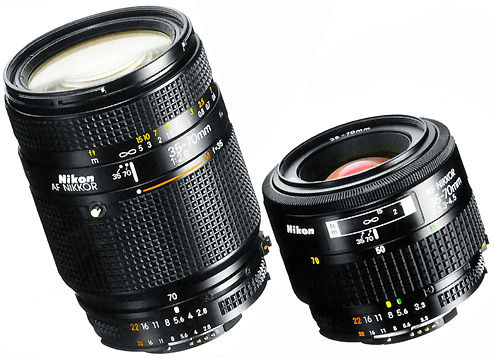 |
Focus control: Via focusing ring at the front end |
Minimum
aperture lock: Provided. Via twist button - an alternate way to verify
this early version
Lens
Coating: NIC (Nikon Integrated lens Coating)
Exposure measurement: Via
full-aperture method with Ai cameras or cameras with CPU interface system; via stop-down
method for other cameras
Infrared compensation index: Two; for the 35mm and 70mm settings
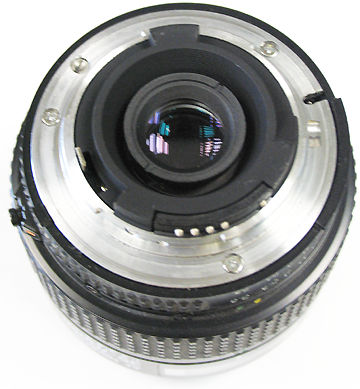 |
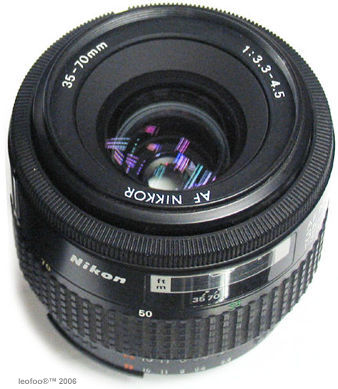 |
Standard accessories: 52mm front lens cap; Rear lens cap LF-1; Hard lens case CL-32S |
Usable Tele-Converters: - TC-201S; TC-14A (Using aperture smaller than f/11, vignetting may occur). Note: both will only offer MANUAL focus only); Nikon does not encourage the use of early AF Teleconverter TC-16S with this AF zoom.
* Other information: This lens cannot be used with AF Finder DX-1 attached to the Nikon F3AF camera. Serial Number for the Nikon AF Zoom Nikkor 28-85mm f/3.5~4.5S lens may have been began from:
AF 35-70/3.3-4.5 plastic focus, twist aperture lock 3+ 2000001 < 2135334 - 22267xx > Sep86 - 226711
AF 35-70/3.3-4.5 high serial nos 3+ 3000001 < 3150585 - 3551364 > - Oct89 5513640 Reference: Roland Vink's lens data sheet.
![]()
Nikon's
AF Zoom
Nikkor 35-70mm f/3.3~4.5N MACRO
(MK II) wideangle-telephoto zoom lens
Year introduced: 1989; Discontinued: 1995/6
 |
|
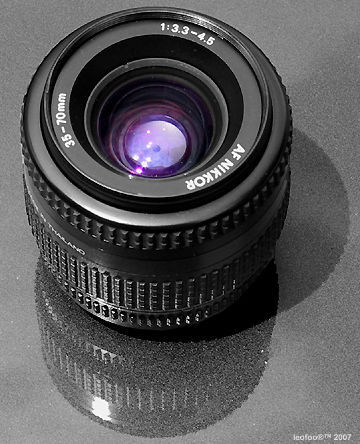 |
The optical composition, close focus performance and basic lens specification of this update is virtually identical to the predecessor (please use the Technical Specification above as the basis for this upgrade). In relation to the few changes made, the thin plastic manual focusing ring which has received so much of criticism has been redesigned wider as well as reverted back using conventional hard rubberized cover. Next, Nikon has also removed the focusing window and the omission of the window may make you mistakenly thinking it is a manual focus zoom lens. The MACRO index line, is now revealed externally at the printed distance scales that extends beyond the marked closest focusing distance of 0.5m. |
 |
A road side scene of a barber shop in the outtskirt of the capital city of Cambodia, Phnom Penh |
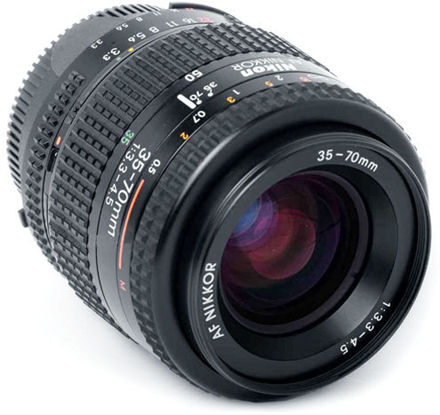 |
|
Credit: Image(s) displayed here are courtesy of betteroffblu/Jenny® where the EBAY STORE is also one of my favorite spot to look for great images on used photographic equipment. Image(s) copyright © 2006. All rights reserved. Please respect the visual property of the contributing photographer.
One of the appealing factor for the 35/70mm is its modest price where Nikon actually had revived the Manual Focus Zoom Nikkor 35-70mm f/3.3~4.5S and sold the lens with the budget models of Nikon FM10 and Nikon FE10 until it was eventually phased out in 2006. Please noted there was a series of this zoom (those with a high serial numbering that begin from 5xxxxxx) were produced in Thailand. Nothing was changed nor quality has been compromised as to the Made in Japan versions. This info is just serving as a reading reference only.
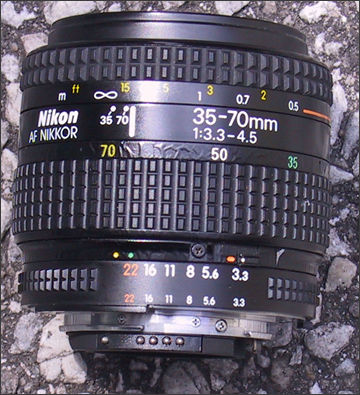 |
|
* Other information:
Serial Number for the Nikon AF Zoom Nikkor 35-70mm f/3.3~4.5S lens may have been
began from:
AF 35-70/3.3-4.5 New rubber focus,
slide aperture lock 3+ 4000001 < 4070967 - 4853088 > Oct89 - 853088
AF 35-70/3.3-4.5 New Made in Thailand 3+ 5000001 < 5071529 - 5133271 >
Reference:
Roland Vink's lens data
sheet.
| NEXT | 1/3 Next
upgrade of the Nikon Autofocus (AF) Zoom Nikkor 35-70mm f/3.3~4.5s
(MK II)
Page
One:- Nikon AF Zoom Nikkor 35-70mm f/3.3~4.5S MK 1 (1986~1989);
MK II (1989~1995/6)
Page Two:- Nikon
AF Zoom Nikkor 35-70mm f/2.8s (1987~1992)
Page
Three:-
Nikon
AF Zoom Nikkor 35-70mm f/2.8D (1992~2006)
Relative: Nikon Manual Focus Zoom-Nikkor 43-86mm f/3.5; MF Nikon Zoom Auto-Nikkor 3.5~8.5cm 1:2.8; Nikon MF Zoom-Nikkor 35-70mm f/3.5; Zoom Nikkor 35-70mm f/3.3~4.5S; Nikon Series E Zoom 36-72mm f/3.5S
| BACK | Main Index Page - Autofocus Nikkor lenses
| Message Board |
for your
Nikkor
Optics
in a shared environment
| Message Board | Specifically for Dispose or Looking for new/used Nikon/Nikkor photographic equipment
| Nippon Kogaku Rangefinder Resources | Nikon F | Nikon F2 | Nikon F3 | Nikon F4 | Nikon F5 | Nikon F6 | Nikkormat / Nikomat | Nikon FM Series | Nikon FE/ FA | Nikon EM/FG/FG20 | Nikon Digital SLRs | Nikon - Other models |
Nikon MF RF-Nikkor lenses for Rangefinder
cameras:-
Main Index Page
Nikon
Auto Focus Nikkor lenses:- Main Index
Page
Nikon
Manual
Focus
Nikkor lenses:-
Fisheye-Nikkor Lenses - Circular |
Full Frame |
Ultrawides Lenses - 13mm15mm18mm20mm |
Wideangle Lenses - 24mm28mm35mm |
Standard Lenses - 45mm 50mm 58mm | Telephoto Lenses
- 85mm105mm135mm180mm & 200mm |
Super-Telephoto Lenses - 300mm 400mm 500mm 600mm 800mm 1200mm |
 |
Special Application
lenses: Micro-Nikkor Lenses - 50mm~55mm -60mm 85mm -105mm 200mm Micro-Zoom 70-180mm Perspective Control (PC) - 28mm 35mm PC-Micro 85mm Dedicated Lenses for Nikon F3AF: AF 80mm f/2.8 | AF 200mm f/3.5 EDIF Depth of Field Control (DC): 105mm 135mm Medical Nikkor: 120mm 200mm Reflex-Nikkor Lenses - 500mm 1000mm 2000mm Others: Noct Nikkor | OP-Nikkor | UV Nikkor 55mm 105mm | Focusing Units | Bellows-Nikkor 105mm 135mm Nikon Series E Lenses: 28mm35mm50mm100mm135mm | E-Series Zoom lenses: 36~72mm75~150mm70~210mm |
MF Zoom-Nikkor Lenses: 25~50mm | 28~45mm | 28~50mm | 28~85mm | 35~70mm | 36~72mm E | 35~85mm | 35~105mm | 35~135mm | 35~200mm | 43~86mm | 50~135mm | 50~300mm | 70~210mm E | 75~150mm E | 80~200mm | 85~250mm | 100~300mm | 180~600mm | 200~400mm | 200~600mm | 360~1200mm | 1200~1700mm
Tele-Converters: TC-1 | TC-2 | TC-200 | TC-201 | TC-300 | TC-301 | TC-14 | TC-14A | TC-14B | TC-14C | TC-14E | TC-16 | TC-16A | TC-20E
Recommended links to understand more technical details
related to the Nikkor F-mount and production Serial Number:
http://rick_oleson.tripod.com/index-153.html by: my
friend, Rick Oleson
http://www.zi.ku.dk/personal/lhhansen/photo/fmount.htm by: Hansen,
Lars Holst
http://www.mir.com.my/rb/photography/hardwares/nikonfmount/lens2.htm
http://www.photosynthesis.co.nz/nikon/serialno.html
Recommended Reading Reference on Nikon cameras and Nikkor lenses | about this photographic web site
| | Back | Main Index Page of Nikkor Resources | Back | Main Index Page of Pictorial History of Nikon SLRs |
| Home - Photography in Malaysia |
![]()
Credit: To all the good
people who has contributed their own experience, resources or those who are kind
enough granting us permission to use their images appeared in this site Note:certain
content and images appeared in this site were either scanned from official marketing
leaflets, brochures, sales manuals or publications published by Nikon over the years
and/or contribution from surfers who claimed originality of their work for educational
purposes. The creator of the site will not be responsible for may discrepancies arise
from such dispute except rectifying them after verification."Nikon", "Nikkormat", "Nippon Kokagu
KK"
& "Nikkor" are registered
tradename of Nikon Corporation Inc., Japan. Site made with an Apple IMac.

